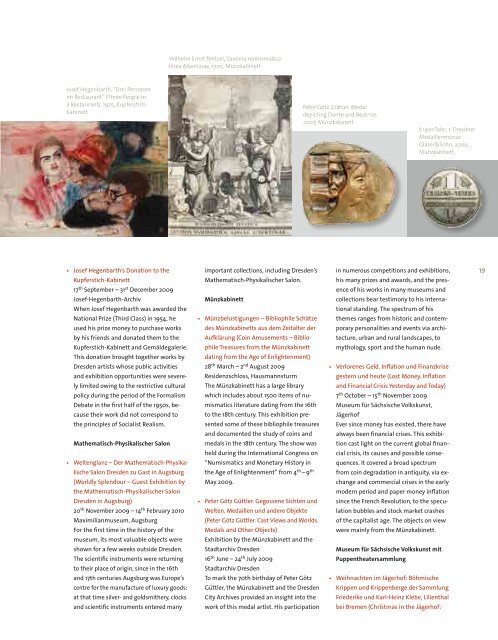2009 - Staatliche Kunstsammlungen Dresden
2009 - Staatliche Kunstsammlungen Dresden
2009 - Staatliche Kunstsammlungen Dresden
You also want an ePaper? Increase the reach of your titles
YUMPU automatically turns print PDFs into web optimized ePapers that Google loves.
Josef Hegenbarth, “Drei Personen<br />
im Restaurant” (Three People in<br />
a Restaurant), 1925, Kupferstich-<br />
Kabinett<br />
• Josef Hegenbarth’s Donation to the<br />
Kupferstich-Kabinett<br />
17th September – 31st December <strong>2009</strong><br />
Josef-Hegenbarth-Archiv<br />
When Josef Hegenbarth was awarded the<br />
National Prize (Third Class) in 1954, he<br />
used his prize money to purchase works<br />
by his friends and donated them to the<br />
Kupferstich-Kabinett and Gemäldegalerie.<br />
This donation brought together works by<br />
<strong>Dresden</strong> artists whose public activities<br />
and exhibition opportunities were severely<br />
limited owing to the restrictive cultural<br />
policy during the period of the Formalism<br />
Debate in the first half of the 1950s, because<br />
their work did not correspond to<br />
the principles of Socialist Realism.<br />
Mathematisch-Physikalischer Salon<br />
• Weltenglanz – Der Mathematisch-Physikalische<br />
Salon <strong>Dresden</strong> zu Gast in Augsburg<br />
(Worldly Splendour – Guest Exhibition by<br />
the Mathematisch-Physikalischer Salon<br />
<strong>Dresden</strong> in Augsburg)<br />
20th November <strong>2009</strong> – 14th February 2010<br />
Maximilianmuseum, Augsburg<br />
For the first time in the history of the<br />
museum, its most valuable objects were<br />
shown for a few weeks outside <strong>Dresden</strong>.<br />
The scientific instruments were returning<br />
to their place of origin, since in the 16th<br />
and 17th centuries Augsburg was Europe’s<br />
centre for the manufacture of luxury goods:<br />
at that time silver- and goldsmithery, clocks<br />
and scientific instruments entered many<br />
Wilhelm Ernst Tentzel, Saxonia numismatica<br />
linea Albertinae, 1705, Münzkabinett<br />
important collections, including <strong>Dresden</strong>’s<br />
Mathematisch-Physikalischer Salon.<br />
Münzkabinett<br />
• Münzbelustigungen – Bibliophile Schätze<br />
des Münzkabinetts aus dem Zeitalter der<br />
Aufklärung (Coin Amusements – Bibliophile<br />
Treasures from the Münzkabinett<br />
dating from the Age of Enlightenment)<br />
28th March – 2nd August <strong>2009</strong><br />
Residenzschloss, Hausmannsturm<br />
The Münzkabinett has a large library<br />
which includes about 1500 items of numismatics<br />
literature dating from the 16th<br />
to the 18th century. This exhibition presented<br />
some of these bibliophile treasures<br />
and documented the study of coins and<br />
medals in the 18th century. The show was<br />
held during the International Congress on<br />
“Numismatics and Monetary History in<br />
the Age of Enlightenment” from 4th – 9th May <strong>2009</strong>.<br />
• Peter Götz Güttler. Gegossene Sichten und<br />
Welten. Medaillen und andere Objekte<br />
(Peter Götz Güttler. Cast Views and Worlds.<br />
Medals and Other Objects)<br />
Exhibition by the Münzkabinett and the<br />
Stadtarchiv <strong>Dresden</strong><br />
16th June – 24th July <strong>2009</strong><br />
Stadtarchiv <strong>Dresden</strong><br />
To mark the 70th birthday of Peter Götz<br />
Güttler, the Münzkabinett and the <strong>Dresden</strong><br />
City Archives provided an insight into the<br />
work of this medal artist. His participation<br />
Peter Götz Güttler, Medal<br />
depicting Dante and Beatrice,<br />
2007, Münzkabinett<br />
in numerous competitions and exhibitions,<br />
his many prizes and awards, and the presence<br />
of his works in many museums and<br />
collections bear testimony to his international<br />
standing. The spectrum of his<br />
themes ranges from historic and contemporary<br />
personalities and events via architecture,<br />
urban and rural landscapes, to<br />
mythology, sport and the human nude.<br />
• Verlorenes Geld. Inflation und Finanzkrise<br />
gestern und heute (Lost Money. Inflation<br />
and Financial Crisis Yesterday and Today)<br />
7th October – 15th November <strong>2009</strong><br />
Museum für Sächsische Volkskunst,<br />
Jägerhof<br />
Ever since money has existed, there have<br />
always been financial crises. This exhibition<br />
cast light on the current global financial<br />
crisis, its causes and possible consequences.<br />
It covered a broad spectrum<br />
from coin degradation in antiquity, via exchange<br />
and commercial crises in the early<br />
modern period and paper money inflation<br />
since the French Revolution, to the speculation<br />
bubbles and stock market crashes<br />
of the capitalist age. The objects on view<br />
were mainly from the Münzkabinett.<br />
Museum für Sächsische Volkskunst mit<br />
Puppentheatersammlung<br />
KrisenTaler, 1. Dresdner<br />
Medaillenmünze<br />
Glaser&Sohn, <strong>2009</strong>,<br />
Münzkabinett<br />
• Weihnachten im Jägerhof: Böhmische<br />
Krippen und Krippenberge der Sammlung<br />
Friederike und Karl-Heinz Klebe, Lilienthal<br />
bei Bremen (Christmas in the Jägerhof:<br />
19

















